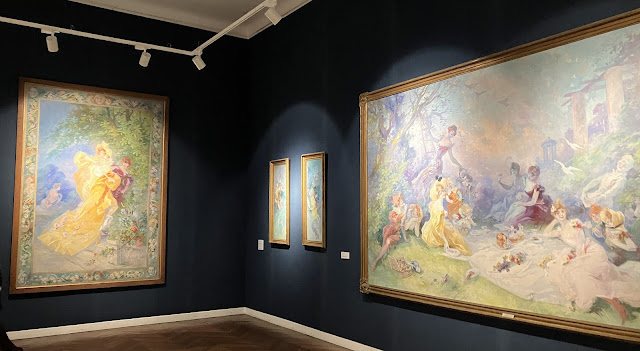I'm not sure if I'm starting to lose my logistical skills or what, but today was a day of extremely poor planning on my part! We tried to take the public bus to the hilltop town of La Turbie, which would have been a 20-minute drive away if we'd only had a car. Instead we waited at a poorly marked bus stop for an hour watching many city busses (that were not our bus) pass us by. And then by chance I looked up and saw a small passenger van with the tiniest sign in the window indicating that it was our bus! I frantically waved to flag it down and we were lucky he stopped at all, since he had to cross two lanes to pull over and pick us up. Whew! After a zig-zagging ride along the sinuous Upper Corniche roadway, we reached the pretty village of La Turbie.
The village itself has cobblestone and brick-lined passages, leading you past many charming stone houses decorated with potted plants and greenery.
There are several original medieval gates that have been restored. This is one of the fortified gates from the 13th century. I love how the plants cling to life, managing to survive in the cracked mortar between the stones.
I know I keep bringing it up, but there is so much ancient Roman history in this region. Romans settled all along the Côte d'Azur. The Via Julia Augusta was the Roman road that linked this part of Gaul (aka France) to Rome.
La Turbie is the site where Augustus based his campaign to conquer this Alpine region. Over the course of a decade, his generals defeated many alpine tribes that resisted Roman rule. To commemorate the victory, an enormous monument called the Tropaeum Alpium ("Trophy of the Alps") was built on the summit overlooking the village.
After the fall of Rome, the trophy was abandoned. Over the centuries it fell into ruin with many of its stones being used to build up the town. This model shows what it would have originally looked like.
But even though only a fraction of it remains today, it is still massively impressive. It looms over the town and can be seen for miles. Unfortunately, poor planning snag #2 had us visiting this town on a Monday -- the one day of the week when the monument is closed! It's surrounded by a high fence so not only could we not get very close, but we also missed out on the museum and park inside. Oh well! We did manage to get another good view of it from the nearby cemetery.
With the two strikes already against me, you think I would've known better for the next stage of our transit plan. But we ended up wasting over an hour waiting for the bus that should have taken us from La Turbie to the village of Èze. When bus after bus (none of which was "our" bus, of course) kept passing by the stop, we finally gave in and called an Uber for the -- I kid you not -- quick ten-minute ride along the Middle Corniche road to get to Èze! It would have taken us less time to walk, except there aren't sidewalks along the narrow twisting road. Anyway, eventually we made it to the very photogenic town of Èze.
Like Saint-Paul de Vence, Èze is a "perched" village and it's known for its botanical garden that showcases cacti and succulents from all over the world. With all the agaves and other desert-dwelling plants, the garden reminded us very much of home. The garden's plants are scattered among the hilltop ruins of the 12th century fortress that used to guard the town. Along the pathways, several sculptures representing Earth Goddesses stand watch over the views.
After visiting the garden we had a nice lunch and took a walk through the narrow streets of this pedestrian-only town. It wasn't too crowded, but there were definitely plenty of other tourists walking around despite it being shoulder season in late October. Wikipedia claims that only about 2000 people live here; I can't imagine living in a town this pretty. Of course it might be less fun to be a resident in the summertime when the throngs of tourists are out in full force.
After seeing the sights, we decided to walk back down to the water along the famous Nietzche's Footpath. German philosopher Friedrich Nietzche came to this part of France to recover from a mental and emotional breakdown. He settled in Èze during the winter of 1883 and spent a great deal of time walking this steep trail. It inspired him to write his most well-known work Thus Spoke Zarathustra.
The path is about 3 miles long and gains almost 1400 feet in elevation. Many people hike up this trail to get to Èze from the coastal town of Èze-sur-Mer below. Maybe they are gluttons for punishment or just never heard of Uber? We cleverly decided to hike it the easy way -- downhill.
Even still, it was quite steep and slow going. But at least we had beautiful scenic views all the way down. We rested a few times to give our knees a bit of a break. The landscape was dry and the air temperature was actually quite warm. If not for the huge expanse of Mediterranean sea below us we could have imagined we were hiking back in Arizona.
Whew! Sweaty and tired, we finally made it to the bottom of the trail. We could look back up the hillside and see how far we'd come -- the town of Èze is somewhere up there out of sight from below. We were so glad we could catch the bus from down here and not have to hike back up!






























































